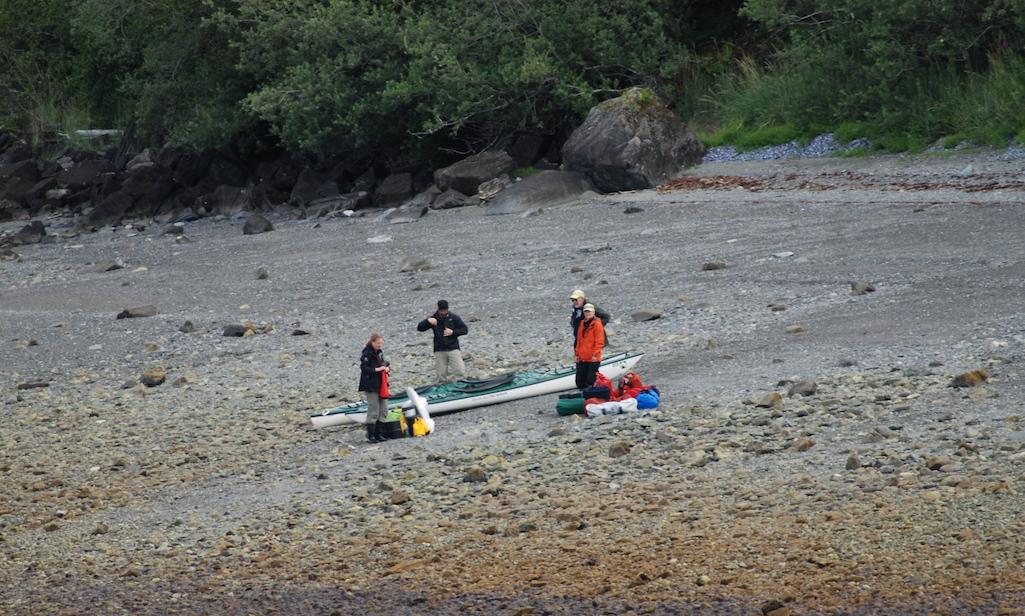
Wildlife in Glacier Bay National Park and Preserve appear to be more sensitive to human presence/Kurt Repanshek file
As more and more visitors to Glacier Bay National Park and Preserve stretch their feet along the shores of the scenic 62-mile-long bay, they are inadvertently driving wildlife deeper into the park, according to a new study.
The scientists behind the study (two from the University of Washington, one from the National Park Service) say shoreline tourism has been growing in the park, largely due to tour vessel passengers. But these shorelines provide denning locations, foraging habitats, and nesting habitat for wildlife. With more and more human visitors going ashore, they are increasing the frequency of human-wildlife interactions.
The researchers' paper, published this past week in the journal People and Nature, says that nearly any level of human activity in a protected area like Glacier Bay can alter the behavior of animals there.
There are no interior roads in the park. Most visitors arrive via plane or cruise ship, and the park has very little human foot traffic, which could explain wildlife's reaction to humans. That lack of human presence made the park a great place to study how wildlife react to seeing humans, according to Laura Prugh, one of the researchers from the University of Washington.

Sea kayakers have much more access to shoreline areas in the sprawling park than cruise ship and small tour boat visitors/Kurt Repanshek file
Using 40 motion-triggered remote cameras, the researchers obtained 183,012 photos of humans and wildlife, including 154,444 photos of humans (84 percent taken at Bartlett Cove), 5,860 photos of brown bears, 3,452 photos of black bears, 6,927 photos of moose, and 570 photos of wolves. Independent detections of each species per camera ranged from 0-8 per week. Human activity ranged from 0-180 camera minutes per week.
Detections did not exceed five per week for any species unless human activity was absent (zero photos of humans were taken). However, spatial and temporal patterns of wildlife activity in relation to human activity were nuanced and species specific, the researchers said.
- Brown bears were unaffected spatially or temporal by human activity.
- Black bears were more likely to be detected in areas of human activity but used those areas less intensely, and when humans were around, black bears shifted their activity patterns slightly to avoid when people were most active.
- Moose were no more likely to be detected in areas of high human-use vs. low human-use and didn’t use either of those areas more intensely than the other. However, when humans were around, moose shifted their activity patterns to align with when people were most active.
- Wolves were no more likely to be detected in areas of high human-use vs. low human-use, however, they used areas of higher human-use more intensely. Wolves also strongly avoided humans, temporally dropping their activity to nearly zero during midday when humans were most active.
Detections of wildlife dropped to zero at all backcountry sites as human activity approached 30 camera minutes, corresponding to ~40 people per week based on a correlation between human camera minutes and number of people per week from camper and tour vessel reports. In Bartlett Cove, detections continued for black bears, brown bears, and moose after this threshold was reached, but wolves were not detected.
“It was eye-opening to see the number of wildlife sightings we are ‘missing’ just by recreating in backcountry areas of Glacier Bay,” said lead author Mira Sytsma, who completed this work as a UW graduate student. “I was surprised that for all four species, wildlife detections were always highest when there wasn't any human activity. So many people visit national parks for the chance to view wildlife, and that desire alone may reduce the chance of it happening.”
Whether the park's wildlife would become more comfortable, or habituated, around human visitors remains to be seen.
"It's certainly possible that wildlife could respond less strongly to people over time as they get used to having them around," Laura Prugh, one of the University of Washington researchers, said in an email to the Traveler. "I think Glacier Bay provides a glimpse of pre-habituation interactions, and perhaps even the habituation process. For example, we found that moose tended to avoid people spatially, but for the moose that didn't avoid people, they shifted the timing of their activity to align better with humans (e.g., moose were more active in the daytime at sites with more visitors).
"Wolves are the main predator of moose and had the strongest avoidance of humans in both space and time, so we think moose may have been using humans as a shield protecting against wolf predation," she added. "Over time, if these moose that associate with people are more successful, that could lead to a habituated population."
The research findings beg a question for National Park System units with wildlife as a main attraction: With more people visiting these areas than ever before, what will be the overall impact on wildlife?
“I expect that similar results [wildlife fleeing human presence] could be found in other national parks, particularly those with relatively low visitation," said Sytsma. "I wouldn't be surprised if more and more people seek out less popular national parks to explore, which will have interesting and important implications for park management and wildlife."



Add comment